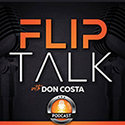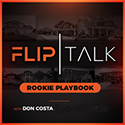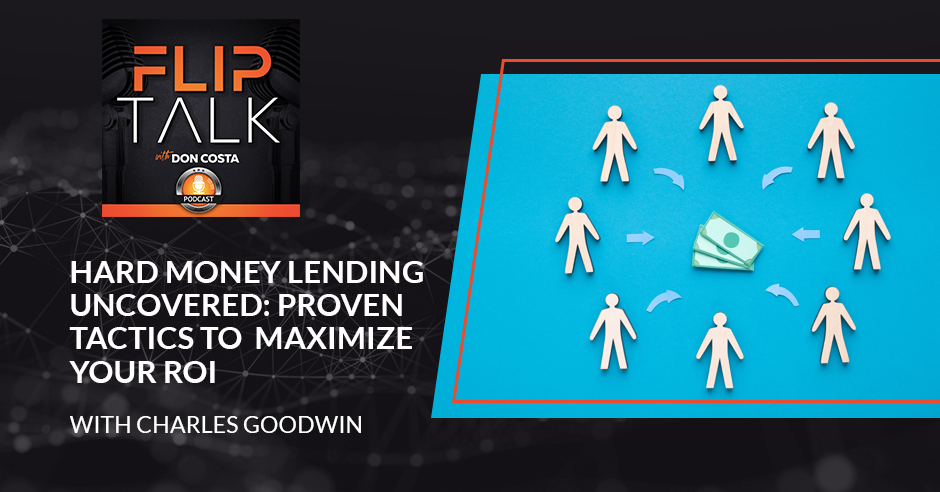Tired of the fear factor around hard money lending? Today, we sit down with Charles Goodwin from Kiavi—one of the industry’s top lenders—to pull back the curtain on smarter, faster financing. Learn proven tactics to boost your ROI on flips, rentals, and new builds. From qualifying to getting funded, Charles shares insider tips to help you navigate private lending with ease. Don’t miss these game-changing insights!
—
Listen to the podcast here
Hard Money Lending Uncovered: Proven Tactics To Maximize Your ROI With Charles Goodwin
We’re going to be talking about all things and money. This is an episode you’re going to want to stay on and read until the end. Before we jump into this, make sure you’re going to FlipTalk.com and check out everything we have going on in the Flip Talk universe. We got some cool stuff coming up. We’re going to be talking with Charles from Kiavi about hard money and how to utilize hard money, especially when your exit strategy is flipping. Charles, how are you doing?
I’m doing very well, Don. Thanks so much for having me. I’m excited to be here.
I’m excited to have you. Kiavi is the beast. It’s the name that I hear from everybody when it comes to borrowing for flips and even rentals. You guys do rentals as well.
We do a little bit of everything.
Let’s talk about just who Kiavi is as a company and maybe explain to me why they’re the name everybody’s throwing around.
Kiavi’s Company Overview & Technological Edge
10,000-foot view of Kiavi, so we are the largest legend in this residential private credit/private lending space. We do fix and flip loans, DSCR loans, construction loans, and portfolio rental loans. You name it. We did $6.5 billion worth of volume in 2024. What makes Kiavi special is for about a decade, we’ve been heavily investing in innovating with our technology and our data models. That investment has led to a solution that makes financing fast, easy, and cost-effective for our clients. That’s what set us apart from the pack and has driven some of the tremendous growth.
You named off a couple of loans that you guys do and I want to stop and educate the audience a little bit because sometimes, what a specific loan type is or how to qualify for it and that thing. A lot of people out there may not understand. When it comes to fix and flip lending, that’s obvious. We’re buying a property and rehabbing it. We’ll get into qualifying for that here in a minute but DSCR. What is that type of loan? Why would somebody use it? How do they qualify for it?
It’s a great question, Don. DSCR stands for debt service coverage ratio. The loan product at it’s core is for a rental property on one property like one asset. This is generally a long-term loan and the difference between this loan and a loan you might get from the bank is that this loan is not underwritten by the borrower’s income. It’s underwritten by the property’s ability, the rent from the property. Its ability to cover the mortgage payments. That service coverage ratio put simply is the rents divided by the principal interest, taxes and insurance. It’s a non-owner-occupied loan that is intended for folks who want to hold properties for cashflow.
You guys do construction loans as well. A high level, what would somebody need to be bringing into the table if they want to do some construction loan with you guys? How would that look?
Construction loan are similar to a fix and flip loan in the fact that they’re generally considered a bridge loan and they’re shorter term. A fix and flip loan is typically a twelve-month loan with Kiavi. A new construction loan with Kiavi is generally a 24-month term and then what you’re looking at is most lenders like Kiavi will lend in the range of 80% to 90% of the all-in cost of the projects. It’s based on the cost basis and then you’re underwriting the ARV.
Simple math. Let’s just do an easy equation. Let’s say you are buying a property for $500,000 and you’re doing a very extensive rehab on it where you’re building an extension to the property. That’ll cost $500,000 so your cost basis is $1 million. Kiavi will typically lend in the range of 80% to 90% of that cost basis. You’re looking at a loan amount in the range of $800,000 to $900,000.
Let’s get to fix and flips since this is more of our audience in the conversation. Hard money can be scary. When somebody comes in, maybe they have no credit or poor credit. It could be their first fix and flip or maybe they’ve done a handful of fix and flips if they haven’t used hard money before. Let’s explain. Let’s take the scary out of hard money. Somebody who doesn’t have great credit or a hard money loan on a good project. Are you guys lending on the project? Are you lending on the person? Is it both? How does all that look?
It’s important to coordinate with the loan officer to ensure you're getting into the right deal. Share on XQualifying For A Loan (Beyond Credit Score)
A little bit of both. We used to call it easy money at the company. The space has transitioned in my opinion over from the term hard money to private credit or private lending. A lender like Kiavi will look at the credit of the individual. As of now, the credit score minimum is 640, though. It’s on the lower side but Kiavi is a lender that doesn’t require prior experience or some lenders will. For example, let’s say you even have mediocre credit and you’re still able to qualify for that but you’ve never flipped the property before.
More of the underwrite is about the property itself. The way the lenders in our space will look at these, including Kiavi, is we’ll look at the purchase price, the renovation cost, and then the after-repair value. That’s why it’s more of an asset base underwrite meaning the asset of the property is what more of the underwrite is based on.
What if somebody is bringing a property to Kiavi to be a potential borrower? What does somebody need in order to qualify the footlong? What should I be prepared to bring you or what should I bring you when I come to you for a loan? What does that need to look like?
The Streamlined Loan Application & Closing Process
It’s a great question. It’s so easy. As I was mentioning earlier, we innovated in our technology or we’ve heavily invested in it to make it easy. The underwrite is very simple. I strongly recommend going to the website and getting pre-qualified. This is where you’ll plug in some basic information about yourself. It should take less than five minutes and we run a soft credit check and a background report on you as the individual. That’s all you need to do to qualify from a financial perspective.
We do lend to entities only. If you want to speed up the process, definitely go get your entity set up but if you have an entity set up and you go through that pre-qualification process and you pass the criteria. Everything else from there is about the property itself. Even right there on the website, you can go and plug in a purchase price of a prospective deal you’re looking at. You can go plug in the renovation cost and the after-repair value. We’ll lay all the terms right out there right in front of you in a matter of minutes. We try to make it super easy on you.
You said background check, so I want to make sure that I’m asking all the questions somebody would ask her that would stop them in their tracks. What are you looking for in a background check that would keep you from lending to somebody?
Generally, bankruptcies in the past two years, felonies in the past seven years and excessive liens and judgments. The rule of thumb is liens and judgments on the background report over $10,000. We’re basically making sure that you don’t have financial crimes on your background. You don’t have a recent bankruptcy or things like that. They’re fairly standard background check items.
We come to you. We passed everything. We’re bringing a project to the table. What is the process once we submit a project like that? What does underwriting look like and how long does it typically take?
It’s a fast process. Kiavi can close loans in as little as five business days and a big advantage of why Kiavi can close loans in as little as five business days is because we do internal valuations on the property itself. Taking a step back and how the process works. You go under contract with the prospective property. Before that, you’ve already priced out your deal and you understand what your terms are going to be. You go under contract, you submit the application, and you’re going to upload a small handful of documents including the purchase contract.
You’re going to let us know who your title and escrow company is. You’re going to let us know who you want to use for property insurance. You’re going to give us your entity documents and other than that, you’re going to go with your scope of work. That’s it. It’s a fairly simple set of documents. That scope of work is essentially just a line item and the costs associated with how you want to renovate that property.
From there, we have concurrent flows where one of them is a loan processor. That loan processor is going to look at your entity documents. Check out if we need anything in addition then on top of that, we’re running a feasibility and evaluation process. We have a few different ways of going about this. For an inexperienced borrower, we’ll typically do an inspection on the property but it’s not an appraisal. It’s just about a business day to get that complete.
From there, we value the property in-house. We have an internal team of appraisers and can get evaluation done very quickly. Being able to do all of those if you’re working with us, can occur in just the matter of a couple of business days. Within a matter of a couple of business days, you will essentially be ready to be underrated and ready to close. We are able to move very quickly. Five to seven business days is generally what we’re calling on the low end.

Hard Money Lending : The Debt Service Coverage Ratio, put simply, is the rent divided by principal, interest, taxes, and insurance. It’s a non-owner-occupied loan designed for those looking to hold properties for cash flow.
We’re talking about a loan amount based on purchase price. You’re going to lend you 80% to 90% of the purchase price. The question I have is, say I’m new and I’ve submitted a property. That gap between my purchase price and the after-repair value of the property isn’t enough to have a profit or at least a prophet that makes the deal a viable deal, which is an issue that happens a lot. People think that there’s profit there when there’s not. You learn that quickly. This is any stop gaps for Kiavi is looking over the individual shoulder and asking that question, “It doesn’t look like you’re going to make any money on this one?” Is it just more so, the ARVs here or the loan is here. We’re good to go?
That’s a great question. The only check related to profitability that we do is that you have what we call a 1.0 ROI and very simple. Let’s say you’re buying your property for $100,000 and then you’re putting in $50,000. The after-repair value needs to be greater than the sum of those to $150,000. We all know that if you sell that property for $151,000 fifty, you’re not making any money on it. Kiavi is willing to do those types of loans because sometimes you might not see eye to eye in the evaluation. Sometimes the rehab might change and things like that.
These loans, the lender is protected from the after-repair value loan to value. For example, Kiavi will typically lend 75% as a total loan amount of that after repair value. If that’s the case and that’s how the numbers come back, you’re looking at more than that 10% down. It might be more like 20% or 30% down, but Kiavi will still do the loan. I would say, overall, we’re still highly invested in the success of an individual.
You have a loan officer that’s able to walk you through these types of details. It’s a great way where you can coordinate with that loan officer to make sure that you’re getting yourself into the right deal. We are not a company that is interested in foreclosing. We’re not a loan-to-own type of company. That’s where the partnership comes in.
You said loan to own and I know a lot of companies that were local companies to my area that back in early 2000s, they would loan to people in foreclosure with the intention to end up with that property at some point.
Not to get into the weeds too much of it. I want to stay at a high level but Kiavi gets institutional capital. If we have high delinquency and high foreclosure rates, we’re not going to attract attractive cost from our institutional capital providers. There’s a mutual agreement here or mutual incentives, as a better way to say that we want to keep low delinquencies and we want our clients to have good outcomes and it works out for everybody.
Now I’ve gotten a loan from you guys. I’m going ahead and doing the project. How do I get the rehab funds for that project? What does that look like? What are the things that I have to do to make sure I’m getting those and getting them at a timely manner?
Accessing Renovation Funds Through Draws & Change Orders
It’s a super easy process for the renovation fund. You can either initiate a draw. It’s done in draws. Let me even take one step back. What that means is, as you are completing the work, we as the lender are reimbursing you for the completed work. You typically do need funds to at least start the renovation. Some folks are able to come up with agreements with their contractor where they’re not paying anything upfront and they’re paying them in three installments at each step of the way. The lenders are able to reimburse you at each step of the way as well.
Generally, I recommend having some of those funds to be able to start the project. Let’s say, you’ve done some of the demo. Let’s say you’ve put in new windows and you’ve just completed the first 20% of the project and you’re ready for a draw. You can initiate it by just going to the website. We have an online portal that you can click and it’ll initiate a draw. You can also reach out to one of your reps or servicing rep. You can initiate a draw that way and it’s an inspection process.
We do allow mobile inspections as well or you can do more of a traditional physical inspection where we send out a third-party vendor. What they’re doing is they’re taking a look at your scope of work based on what you originally gave us at the closing of the loan and are saying, “This person said they were going to replace eight windows and that cost them $5,000.” The inspector goes and we see eight new windows. We’re reimbursing you $5,000 for that. At its core, it’s a reimbursement based on percentage complete of any individual line item.
I’ve heard stories and I just want to throw this question out there so people understand what they can and can’t do. Say I’ve done a project. I have a scope of work and then something comes up outside of my scope of work that needs to be done on that project. I have done a windows plus something outside of my scope of work. I’m looking to draw on my spend, which includes that something outside of that scope of work. Is Kiavi going to have any issue with, “This was an endoscope of work type of thing, so you can’t draw on that?”
I can explain how we do this type of thing. First and foremost, I’ll say, I fully understand that construction project’s change. I’ve purchased over 50 residential properties myself for a combination of flips and rentals and things change, so we get it. The way we like to handle this is we do what we call a change order. We’ll give you your original scope of work, so you have in front of it and you can tell us that, “This is how it has now shifted.”
We’re not in the business of letting you fail. If what you’re doing makes sense—and we can prove it—we’re here to work with you. Share on XWe as a lender can’t proactively go add funds to the total loan amount but we certainly can shift them around. We’re careful about making sure somebody isn’t front loading a scope so the lenders are not over reimbursing somebody along the way. If you have genuinely produced or paid for and installed a different line item that you weren’t inspected or weren’t expecting. We’ll go on completing the change order and then start reimbursing you for that side of it as well or that part of it as well. As I mentioned earlier, we’re not in the business to have you fail as long as what you’re doing makes sense and we can prove that what you did make sense, then it’s something that we want to work with.
I don’t think I have any more questions. I think I asked them all. People run into issues. Projects take longer than expected. Now, you guys lend for a year, so I can’t foresee anybody taking longer than a year on their project but I’m sure it happens. I’m not putting this out there for anybody take advantage of this so make sure readers are reading that.
Also, a lot of people when they run into an issue, they’ll isolate and they want to ask questions. They’ll stick their head in the sand and hide. Say somebody gets into a situation where maybe they’ve hit a funding wall. They run out of funds on a project or it’s taking long than expected. This is a conversation they should be having with Kiavi right away. This is not something to be hiding from.
Managing Projects & Communication With Lender
The best thing that you can do is communicate with your lender. I know sometimes it seems counterintuitive to somebody that they’re worth, “I’m starting to fail on my project. The lender is just going to start foreclosure right away.” That is not what a lender like Kiavi is interested in doing. The best thing that you can do is be communicating early and be communicating often because you do have options when you run into trouble. There are a few different options.
You can always extend a loan. Lenders like Kiavi offer extensions. For example, you could pay a fee to take the loan from a 12-month to a 15-month term, for example. Depending on the situation. We may also offer you a refinance to refinance your current loan into a brand-new loan and then there are also other different sorts of workouts that you can do with a lender and we have a large network of other investors too that may be able to help in certain scenarios as well. The best thing you can be doing is communicating early and often and that’ll help reach a mutual outcome. That’s the best given the situation.
I want to hone in on that Kiavi’s been doing. There are options to have a conversation about and it’s important to have a conversation about those options sooner than later because usually, if we can get in front of a problem, it can be correctable. Sometimes, you guys may see something that the person that’s in the weeds don’t see versus you get to a point where now the relationship’s damaged and it changes the ball game.
Kiavi funded 20,000 loans in 2024. We’ve built up a large network, a large amount of data, and a large amount of experience to be able to navigate these types of scenarios. We’ve seen all of it. We seen that everything few and far between. Please be communicating if something like that comes up. As I mentioned several times, the goals to have a positive outcome for all.
Tell me how to get a hold of you if they want to find you? How do they get a hold of Kiavi if they want to do a loan with Kiavi?
The best way to get in touch is go to the website at Kiavi.com. There’s a button that can say see your rate or start new loan and that’s the way to go through the pre-qualification process. As soon as you do that, you’ll be assigned to a salesperson. If you want to also just talk to a salesperson right away, you can email Sales@Kiavi.com. It’s another way to get in touch. I’m available easily on LinkedIn. You can find me everywhere. Google my name, Charles Goodwin on LinkedIn. That’s a great way to find me.
I appreciate your time, Charles.
Thank you. Thanks for having me.
If you got value out of this episode, make sure that you’re going and checking out Kiavi and what they can do for you as a rehabber or even in the buy an old arena. Don’t forget they do the new construction loan. Always check out FlipTalk.com. Again, we do all kinds of new updates. We have some cool tools and resources there. If you have any questions or comments, you want to tell me how much you love to show. You can always email me at Don@FlipTalk.com. Charles, thank you for your time.
Important Links


